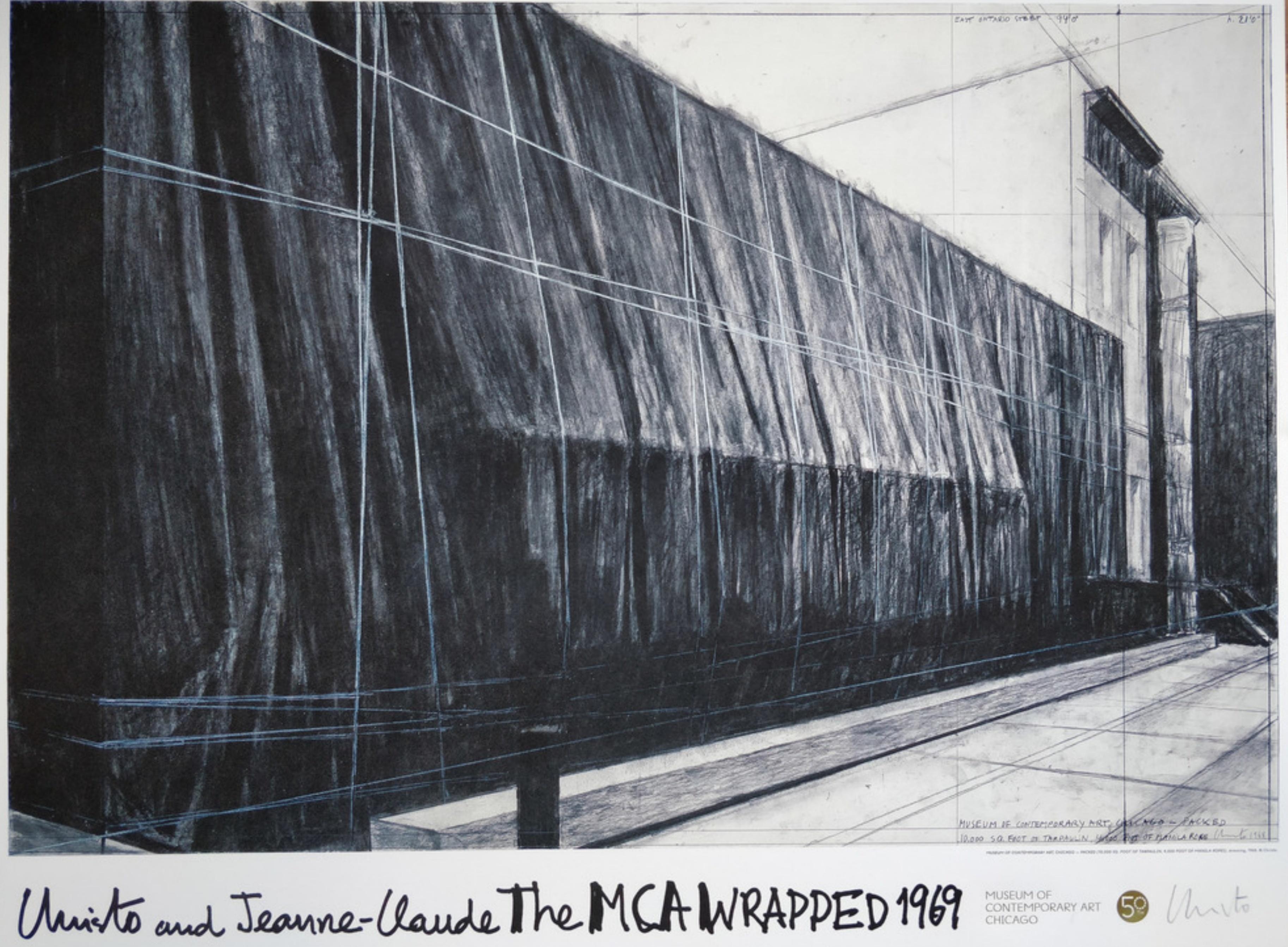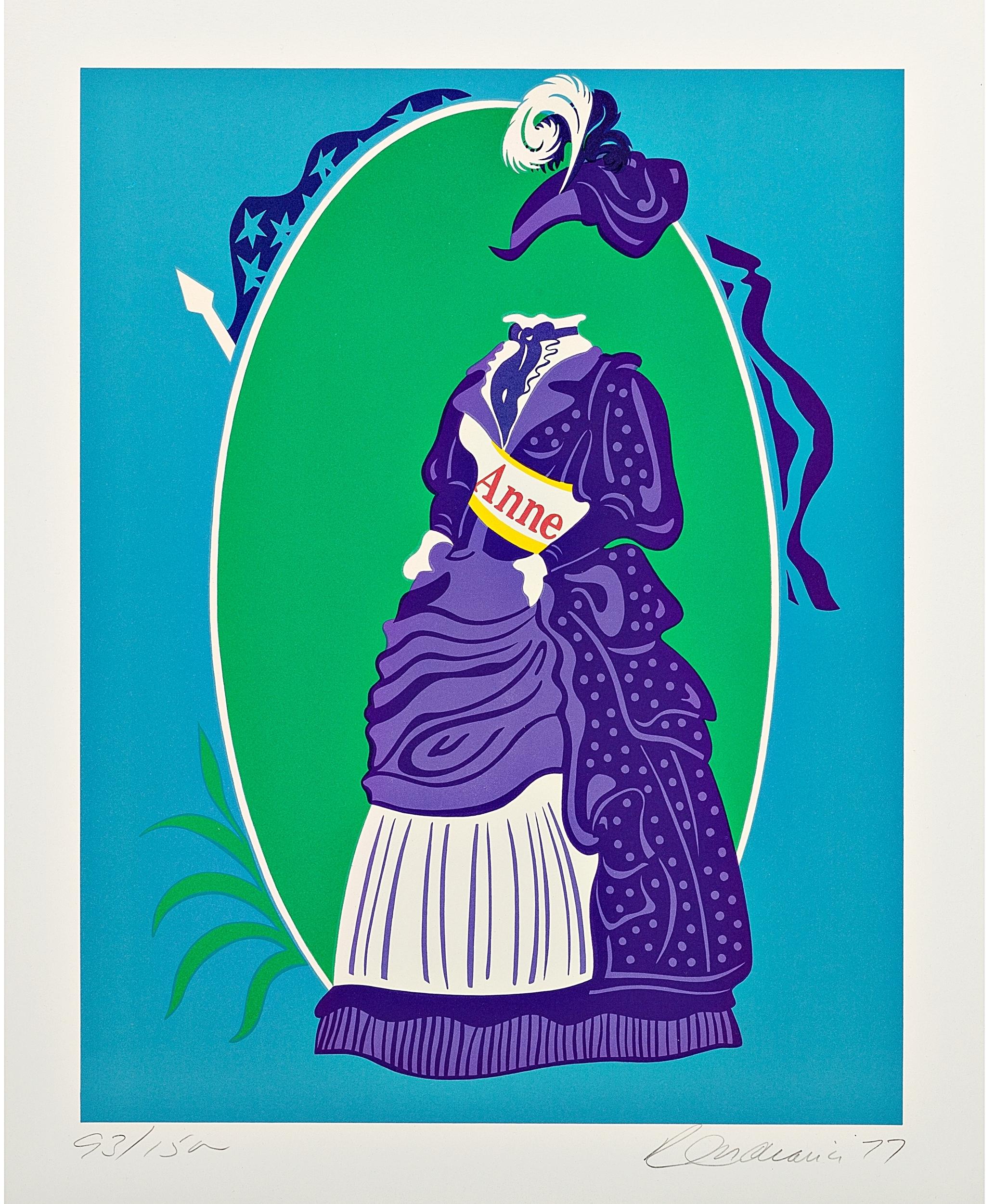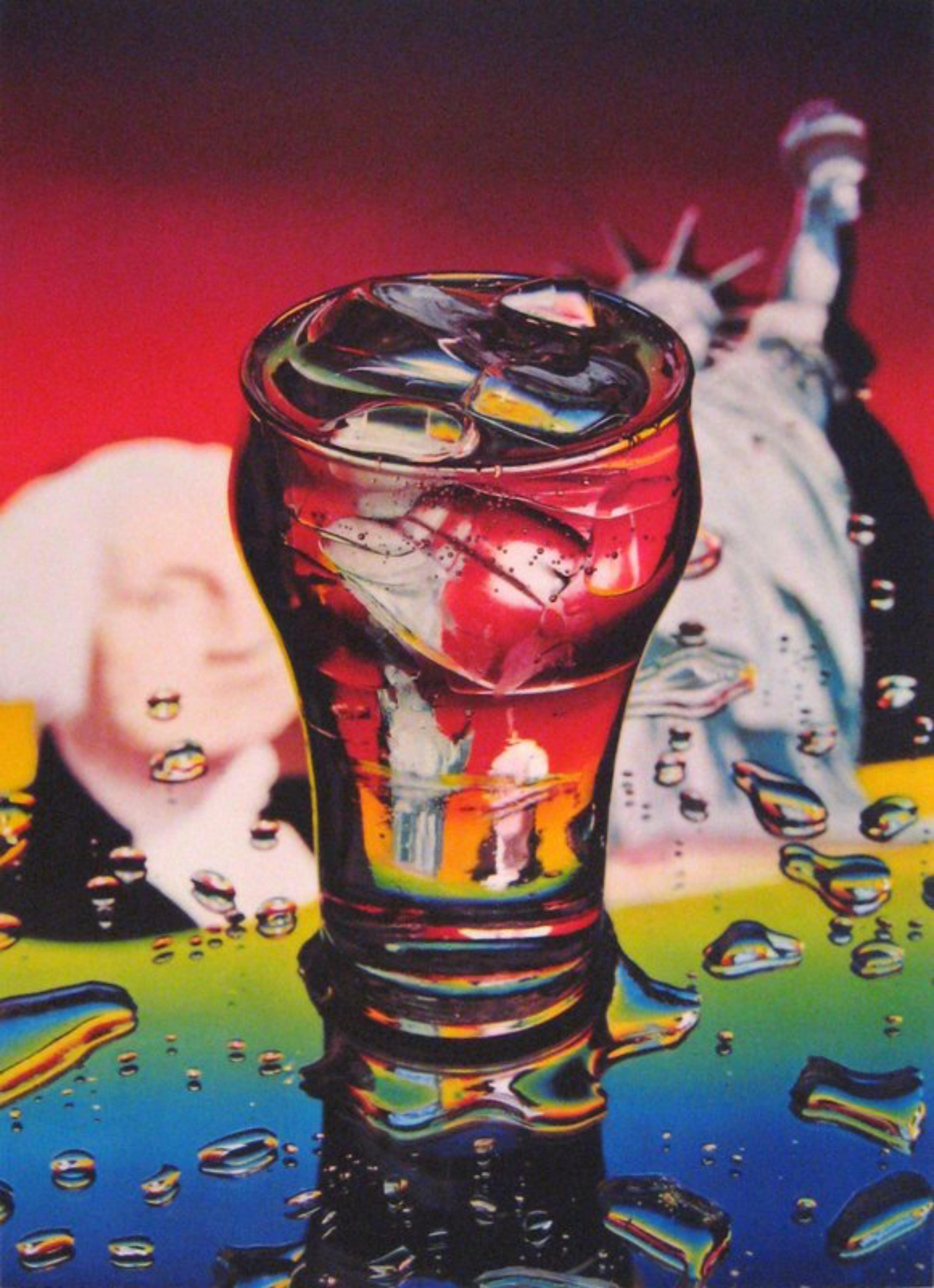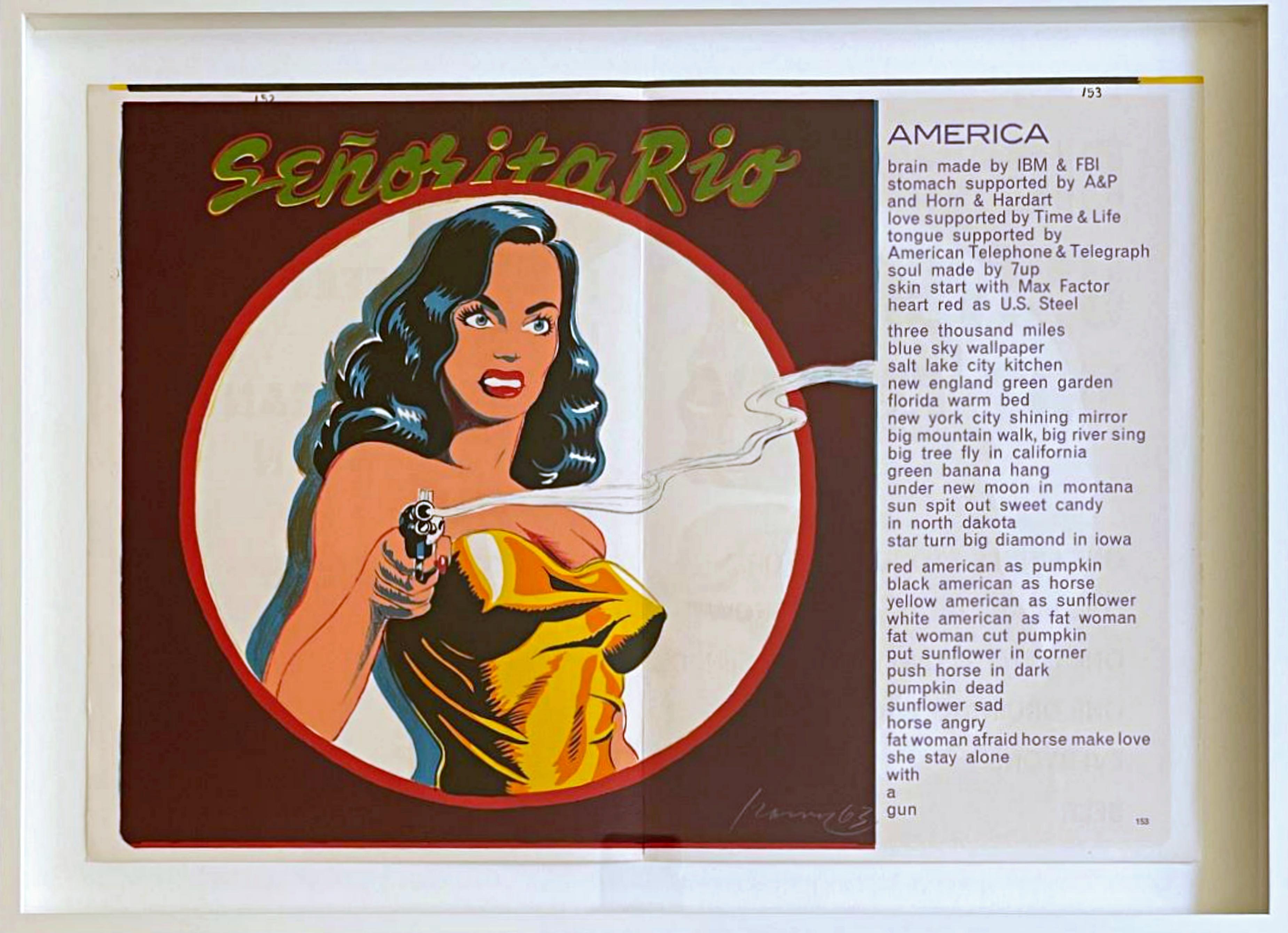Claes OldenburgRolling Collar and Tie (Axsom/Platzker 259) iconic Pop Art lithograph Ed of 52 1995
1995
About the Item
- Creator:Claes Oldenburg (1929, American, Swedish)
- Creation Year:1995
- Dimensions:Height: 40 in (101.6 cm)Width: 29.75 in (75.57 cm)Depth: 1 in (2.54 cm)
- Medium:
- Movement & Style:
- Period:
- Condition:fine vintage condition; held in original vintage wood frame (frames not guaranteed).
- Gallery Location:New York, NY
- Reference Number:1stDibs: LU1745213900052
Claes Oldenburg
One of the original Pop artists, Claes Oldenburg was born in Stockholm. The son of a Swedish diplomat, he spent his early years in Stockholm and Oslo until the family moved to Chicago in 1937.
Oldenburg attended Yale University, then returned to Chicago, where he worked for a newspaper and also attended drawing classes at the Art Institute. He moved to New York in 1956.
Oldenburg’s early art in New York were works of urban realism in cardboard and paper that were influenced by the work of Dubuffet and the New Realists, and were seen as a brutal response to society. In 1961 Oldenburg rented a storefront on the Lower East Side and sold brightly painted plaster objects as well as three-dimensional and wall reliefs based on hamburgers, pastries, men's and women's clothing, and other commodities. The signature soft sculptures followed, objects of commonplace household objects made of vinyl or canvas stuffed with kapok. These pieces transformed the medium — the soft sculptures are intended to be sensual experiences and commentary on our material world of objects and our relationship to them.
In 1965, still working in vinyl, plaster and cardboard, Oldenburg began making large works termed “Colossal Monuments,” which are large public sculptures with public and private meanings. In the 1970s, Oldenburg was fabricating large-scale works in durable materials such as steel, and working with Coosje van Bruggen, he had received many such public commissions in the United States and Europe.
Find authentic Claes Oldenburg sculptures, prints and other art on 1stDibs.
(Biography provided by Art Commerce)
- ShippingRetrieving quote...Ships From: New York, NY
- Return PolicyA return for this item may be initiated within 1 day of delivery.
- The Wrapped (MCA), Chicago 1969 (Limited Edition of 200, Hand Signed by Christo)By Christo and Jeanne-ClaudeLocated in New York, NYChristo and Jeanne-Claude The Wrapped (MCA), 1969 (Hand Signed), 2019 Four-color offset lithograph on 110 lb. Crane Lettra Cover stock, with an elegant gold foil stamp. Hand Signed by Christo 22 3/5 × 30 inches Edition of 200 Hand-signed by artist, Signed in graphite pencil by Christo on the front. Also elegant gold foil stamp. Unnumbered from the documented limited edition of only 200 Published by Museum of Contemporary Art, (MCA) Chicago Unframed A great gift for anyone with ties to Chicago! This limited-edition, hand signed offset lithograph on 110 lb. Crane Lettra Cover stock commemorates Christo's exhibition "Wrap In Wrap Out", which took place at the MCA’s original location on 237 East Ontario Street, Chicago. The project became the first public building Christo and his wife, Jeanne-Claude, wrapped in the United States. In an illuminating 2010 article entitled, "A daring plan to wrap a Chicago museum raises city ire – and makes art history," author Robin Amer recounts how Christo came to choose Chicago -- or rather how Chicago chose New York based artist Christo: "During a recent conversation he [Christo] ticked off the list of buildings he approached in downtown Manhattan starting in 1961. “Number 2 Broadway, number 20 Exchange Place,” he recalled. “We tried to wrap a building at Times Square. They all said no. Christo said he quickly realized that his best hope to wrap a building – his first in North America – would be to wrap a museum, which might be more amenable to his strange proposition.Christo and Jeanne-Claude approached New York’s Museum of Modern Art in 1967. The museum was interested, but Christo said they failed to secure permission for the show from the New York Fire...Category
1960s Pop Art Abstract Prints
MaterialsFoil
- LOVE in Central Park, New York Pencil Signed and numbered 66/89, Historic printBy Robert IndianaLocated in New York, NYRobert Indiana LOVE in Central Park, New York, 1971 Color lithograph on wove paper. Pencil signed, dated and numbered with LOVE drawing/flourish Hand-signed by artist, Pencil signed, dated and numbered 66/ 89. Also bears a drawing of the stacked letters LOVE in pencil. Bears Robert Indiana's copyright Published by Robert Indiana and printed by the American Poster Company to raise money for Central Park 39 × 30 inches Unframed This impressively large 1971 lithograph - pencil signed and numbered from the limited edition of only 89, with a stacked LOVE drawing on the front - depicts Robert Indiana's iconic LOVE sculpture (from the permanent collection of the Indianapolis Museum of Art) when it was exhibited at Central Park in New York City. This was the turn of the decade of the 1970s - during the height of the anti-Vietnam War protests of the Nixon Administration, when the presence of Indiana's monumental cor-ten steel LOVE in Central Park took on a much deeper significance in New York and indeed the country. This important print is pencil signed, dated and numbered by Robert Indiana from the very small edition of only 89. It also bears a drawing - a flourish - of the word LOVE written by the artist in pencil. Very few of the signed editions of this print remain -- so it is rarely seen on the market. Indeed, eighty nine (89) is a very small edition; however, this oversized print was used for promotional purposes in public places, so very few of the 89 signed and numbered works remain - let alone with the original stacked love drawing. . If you LOVE Robert Indiana...Category
1970s Pop Art Abstract Prints
MaterialsLithograph, Pencil, Offset
- Anne, inspired by Gertrude Stein's opera about Susan B. Anthony Signed/N printBy Robert IndianaLocated in New York, NYRobert Indiana Anne inspired by Susan B. Anthony, 1977 Color Lithograph on Arches Paper Hand Signed, dated and numbered 93 from the limited edition of 150 (93/150) front in graphite ...Category
1970s Pop Art Figurative Prints
MaterialsLithograph, Pencil
- Thou Shalt Have No Other Gods Before Me (The First Commandment)By Kenny ScharfLocated in New York, NYKenny Scharf Thou Shalt Have No Other Gods Before Me (The First Commandment), 1987 5-Color lithograph on Dieu Donne handmade paper with deckled edges 24 × 18 inches Hand signed, date...Category
1980s Pop Art Abstract Prints
MaterialsLithograph, Pencil, Graphite
- Yankee Flame Pop Art photorealist Lt Ed Signed/N. Statue of Liberty US PresidentBy Ben SchonzeitLocated in New York, NYBen Schonzeit Yankee Flame, from the portfolio: America: the Third Century, 1975 Collotype on wove paper Pencil signed and numbered 50/200 on the front Publisher: APC Editions, Chermayeff & Geismar Associates, Inc Printer: Triton Press 27 × 19 3/10 inches Unframed Note: this is the original hand signed and numbered collotype; not to be confused with the separate (unsigned) poster edition. This hand-signed, numbered and dated collotype in colors by photorealist pioneer artist Ben Schonzeit was created in 1975 for the portfolio America: the Third Century, commissioned by Mobil Oil Corporation in which 13 American artists, including Roy Lichtenstein, Ed Ruscha, Robert Rauschenberg, James Rosenquist and others created works celebrating America's bicentennial. Yankee Flame combines the iconic images of George Washington, Coca-Cola and the Statue of Liberty into a collaged interpretation of contemporary American life and the meaning of freedom. "Yankee Flame" is in excellent condition and never framed. It was acquired as part of the America: The Third Century full portfolio. Ben Schonzeit (b. 1942, Brooklyn, New York) is one of the original Photorealist painters and is considered to have pioneered the airbrush technique. His works often depict still life arrangements that are intentionally out of focus. He received his B.F.A. from The Cooper Union in 1964 and has since had over 50 solo exhibitions both in the United States and abroad. His paintings are held in numerous museum collections including the Solomon R. Guggenheim Museum in New York, Virginia Museum of Fine Arts in Richmond, Virginia, and the Metropolitan Museum of Art in New York. In 1973 Nancy Hoffman introduced me to Ben Schonzeit in the backroom of her gallery on West Broadway. She had been open less than a year, and Ben was one of the artists in her original stable. His large Crab Blue It had arrived from his studio a few days earlier and was leaning against the wall. I thought at the time it was one of the most impressive, virtuosic Photorealist works I had seen. That first encounter was more than a quarter of a century ago and I have always considered it to be one of the quintessential, tour de force paintings of American Photorealism. In the early seventies one could stand on West Broadway on any pleasant, sunny weekday and see less than a dozen people on the street between the Nancy Hoffman Gallery and OK Harris Works of Art. Almost all of the SoHo galleries, such as Leo Castelli, Paula Cooper, Ward-Nasse, and Ivan Karp’s Hundred Acres, could be visited in an afternoon. At night the streets were almost deserted. With the exception of Andy Warhol, there were no art world superstars. More importantly, none of the artists expected to achieve celebrity status. That was a phenomenon of the eighties and nineties. There were a only a handful of restaurants and watering holes, such Elephant and Castle, Fanelli’s, the Spring Street Bar and Prince Street Bar. Fanelli’s closed on weekends, which was a holdover from their sweatshop clientele during lunch and ragtag group of artists in the evenings. In those early days of SoHo, the drafty, raw sweatshop spaces with their large windows, rough floors, and service elevators provided large, inexpensive living quarters and studios for many artists. Unlike today, there were no boutiques. The area was not chic and with the exception of Lowell Nesbett’s showplace, the lofts were not glamorous. Schonzeit was in the same living and working space the he now occupies when I first visited him, but SoHo was a very different time and place. When the National Endowment of the Arts recommended me to curate America 1976, which turned into one of the major visual arts projects for the Bicentennial, Ben Schonzeit was on the first list of participants I made up for the U.S. Department of the Interior. His large diptych, Continental Divide, was one of the most memorable works produced for the exhibit. I stopped by his studio four or five times while it was in progress and have visited him many times over the years. We have maintained a very cordial working relationship and friendship over the past three decades. I saw The Music Room exhibit in 1978 and realized at the time that the vigorously rendered mural sized canvases and mirror and related works represented a major catharsis in his painting. In many ways, it and the other paintings and drawings based on the same image represented a sharp, decisive break with the tenets of Photorealism, or at least the photo-replicative aspects that had been so widely heralded in America and abroad in the mid-seventies. Over the years we have continued to work together. He has been in almost all of the major exhibitions I have curated here and abroad and in almost all of the books I have written. I am familiar with his studio habits, his quiet, internalized restlessness that manifests itself in the hundreds of small, unknown drawings and watercolors, doodles on napkins during lunch, and imaginary landscapes. I also know that he would rather do a painting than think or talk about it. Over the years I have followed the shifts in his studio procedure from the monumental airbrushed fruit and vegetable paintings to the most recent bouquets of flowers and decorative paintings. Our discussions of these matters tends to lapse into a verbal shorthand at this point. The following essay is based on both my longstanding familiarity and admiration for his work and involvement with contemporary realism and figurative painting. A booklet of color xeroxes with notes made up by Schonzeit was extremely helpful. In addition to several interviews, much of the information unfolded through a lengthy series of Emails. Due to our different working habits these were composed and sent out very late at night and answered by Ben the following morning. They dealt with the specifics of many of the paintings, generalities, his background and childhood in Brooklyn, and occasional bits of art world gossip. And there were odd discoveries. Prior to discussing his witty, tongue in cheek painting of Buffalo Bill, I did not know or had long forgotten that William Cody...Category
Mid-20th Century Pop Art Abstract Prints
MaterialsOther Medium, Pencil, Lithograph
- Señorita Rio, from the Deluxe signed edition of 1 Cent Life Portfolio (85/100)By Mel RamosLocated in New York, NYMEL RAMOS Señorita Rio, from the Deluxe signed edition of 1 Cent Life (Artists & Collaborators), 1963 Color lithograph on wove paper Hand signed and dated on the lower right front; print numbered on the colophon page a copy of which is affixed to the back of the frame (see photo) Edition 85/100 Published by E.W. Kornfeld, Germany, Written by Walasse Ting, Edited by Sam Francis Framed: Elegantly floated and framed in a museum quality wood frame with UV plexiglass Provenance: Acquired from original, complete 1 Cent Life Portfolio, # 85/100 (Artists & Collaborators) from the Estate and Collection of Robert Indiana This original lithograph, splayed across two pages, is from the Deluxe edition of the legendary 1 Cent Life Portfolio, one of the most documented and celebrated artistic collaborations of the 1960s. Chinese American artist and writer Walasse Ting, in collaboration with Sam Francis, assembled a group of the most significant Pop and Abstract Expressionist artists in America, including Pop Artist Mel Ramos, along with the European COBRA artist to create the definitive artistic portfolio, with text by Walasse Ting. The Deluxe edition, which features hand signed prints was published in a limited edition of only 100. This is one of them. Of the 100, editions numbered 60-100, or 40 portfolios, were reserved exclusively for Artists & Collaborators. This hand signed Mel Ramos lithograph is from the portfolio numbered 85 (Artists & Collaborators), which was acquired from the Estate and Collection of Robert Indiana, one of the artists who contribute to the 1 Cent Life portfolio. The racy text to the right of the print -- an anti-Corporate American screed, was written by Walasse Ting. It is elegantly floated and framed in. amuseum frame with UV plexiglass. Signed examples of this portfolio with such superb provenance rarely appear on the marketplace. This is a true collectors item, from the most desirable and influential era in Pop Art history. Mel Ramos became famous for his ironic portraits of pin ups and how they are used in American advertising. (see detailed biography below). The poem called America to the right of the lithograph, entitled "America" was written by Chinese born artist Walasse Ting, and matches the image perfectly, as it's also a commentary on American commercial culture. The poem begins: Brain made by IBM & FBI stomach supported by A & P and Horn & Hardart love supported by Time & Life tongue supported by American Telephone & Telegraph soul made by 7up skin start with Max Factor heart red as U.S. Steel Measurements: Framed 19 inches vertical by 26 inches by 2 inches Lithograph 16 inches vertical by 22.5 inches More about the Signed (Deluxe) Edition of 1 Cent Life portfolio In 1962, the Chinese-American artist Walasse Ting shared his dream project with painter Sam Francis: to create an anthology of his poetry illustrated by leading artists of their time. Over the next two years, Ting and Francis recruited leading Abstract Expressionists and Pop artists—Andy Warhol, Joan Mitchell, Robert Rauschenberg...Category
1950s Pop Art Abstract Prints
MaterialsLithograph, Pencil
- Views of Hotel Well I, from Moving Focus seriesBy David HockneyLocated in Aventura, FLViews of Hotel Well I, from Moving Focus series (T. 280; DH. 67). Lithograph printed in colors on TGL handmade paper. Hand signed, dated and numbered by the artist. original Artist's...Category
1980s Pop Art Figurative Prints
MaterialsPaper, Lithograph
- Saul Steinberg lithograph 1970s (Saul Steinberg prints)By Saul SteinbergLocated in NEW YORK, NYVintage Saul Steinberg Lithograph Published by: Galerie Maeght, Paris, c.1970 Portfolio: Derrière le miroir Excellent frame piece Lithograph in colors 15 x 22 inches Fold-line as i...Category
1970s Pop Art Figurative Prints
MaterialsLithograph
- Basquiat Paris 1998 (vintage Basquiat announcement)By after Jean-Michel BasquiatLocated in NEW YORK, NYBasquiat Paris 1998: Rare vintage original announcement card to the exhibit, Jean-Michel Basquiat Temoignage 1977-1988, Galerie Jerome De Noirmont, Paris, 1998: 6 x 9 inches (folde...Category
1980s Pop Art Figurative Prints
MaterialsOffset, Lithograph
- 1970s Surrealist Pop Art Nude Angel Lithograph Print Psychedelic ColorLocated in Surfside, FLHand Signed verso D. Herbert and numbered 1 of 20. (possibly Don Herbert)Category
20th Century Pop Art Abstract Prints
MaterialsLithograph
- Joe Tilson British Pop Art Screenprint, Color Lithograph 4 Seasons 4 ElementsBy Joe TilsonLocated in Surfside, FLSilkscreen screenprint or Lithograph Hand signed and numbered. An esoteric, mystical, Kabbala inspired print with Hebrew as well as other languages. Joseph Charles Tilson RA (born 2...Category
1970s Pop Art Abstract Prints
MaterialsLithograph, Screen
- Judy Rifka Abstract Expressionist Contemporary Lithograph Hebrew 10 CommandmentBy Judy RifkaLocated in Surfside, FLJudy Rifka (American, b. 1945) 44/84 Lithograph on paper titled "Thou Shalt Not Bear False Witness against Thy Neighbor"; Depicting an abstract composition in blue, green, red and black tones with Hebrew script. Judaica interest. (I have seen this print described as a screenprint and as a lithograph) Hand signed in pencil and dated alongside an embossed pictorial blindstamp of a closed hand with one raised index finger. Solo Press. From The Ten Commandments Kenny Scharf; Joseph Nechvatal; Gretchen Bender; April Gornik; Robert Kushner; Nancy Spero; Vito Acconci; Jane Dickson; Judy Rifka; Richard Bosman and Lisa Liebmann. Judy Rifka (born 1945) is an American woman artist active since the 1970s as a painter and video artist. She works heavily in New York City's Tribeca and Lower East Side and has associated with movements coming out of the area in the 1970s and 1980s such as Colab and the East Village, Manhattan art scene. A video artist, book artist and abstract painter, Rifka is a multi-faceted artist who has worked in a variety of media in addition to her painting and printmaking. She was born in 1945 in New York City and studied art at Hunter College, the New York Studio School and the Skowhegan School of Painting and Sculpture in Maine. Rifka took part in the 1980 Times Square Show, (Organized by Collaborative Projects, Inc. in 1980 at what was once a massage parlor, with now-famous participants such as Jenny Holzer, Nan Goldin, Keith Haring, Kenny Scharf, Jean-Michel Basquiat, and Kiki Smith, the roster of the exhibition reads like a who’s who of the art world), two Whitney Museum Biennials (1975, 1983), Documenta 7, Just Another Asshole (1981), curated by Carlo McCormick and received the cover of Art in America in 1984 for her series, "Architecture," which employed the three-dimensional stretchers that she adopted in exhibitions dating to 1982; in a 1985 review in the New York Times, Vivien Raynor noted Rifka's shift to large paintings of the female nude, which also employed the three-dimensional stretchers. In a 1985 episode of Miami Vice, Bianca Jagger played a character attacked in front of Rifka's three-dimensional nude still-life, "Bacchanaal", which was on display at the Museum of Art Fort Lauderdale. Rene Ricard wrote about Rifka in his influential December 1987 Art Forum article about the iconic identity of artists from Van Gogh to Jean-Michel Basquiat and Keith Haring, The Radiant Child.The untitled acrylic painting on plywood, in the collection of the Honolulu Museum of Art, demonstrates the artist's use of plywood as a substrate for painting. Artist and writer Mark Bloch called her work "imaginative surfaces that support experimental laboratories for interferences in sensuous pigment." According to artist and curator Greg de la Haba, Judy Rifka's irregular polygons on plywood "are among the most important paintings of the decade". In 2013, Rifka's daily posts on Facebook garnered a large social media audience for her imaginative "selfies," erudite friendly comments, and widely attended solo and group exhibitions, Judy Rifka's pop art figuration is noted for its nervous line and frenetic pace. In the January 1998 issue of Art in America, Vincent Carducci echoed Masheck, “Rifka reworks the neo-classical and the pop, setting all sources in quotation for today’s art-world cognoscenti.” Rifka, along with artists like David Wojnarowicz, helped to take Pop sensibility into a milieu that incorporated politics and high art into Postmodernism; Robert Pincus-Witten stated in his 1988 essay, Corinthian Crackerjacks & Passing Go that "Rifka’s commitment to process and discovery, doctrine with Abstract Expressionist practice, is of paramount concern though there is nothing dogmatic or pious about Rifka’s use of method. Playful rapidity and delight in discovery is everywhere evident in her painting." In 2016, a large retrospective of Rifka's art was shown at the Jean-Paul Najar Foundation in Dubai. In 2017, Gregory de la Haba presented a Rifka retrospective at the Amstel Gallery in The Yard, a section of Manhattan described as "a labyrinth of small cubicles, conference rooms and small office spaces that are rented out to young entrepreneurs, professionals and hipsters". In 2019 her video Bubble Dancers New Space Ritual was selected for the International Istanbul Bienali. Alexandra Goldman Talks To Judy Rifka About Ionic Ironic: Mythos from the '80s at CORE:Club and the Inexistence of "Feminist Art" Whitehot Magazine of Contemporary Art. She was included in "50 Contemporary Women Artists", a book comprising a refined selection of current and impactful artists. The foreword is by Elizabeth Sackler of the Brooklyn Museum’s Sackler Center for Feminist Art. Additional names in the book include sculptor and carver Barbara Segal...Category
1980s Pop Art Abstract Prints
MaterialsLithograph, Screen
Recently Viewed
View AllRead More
10 Must-Visit American Public Sculptures
Get your dose of Vitamin D while surveying works by the likes of Alexander Calder, Keith Haring and Pablo Picasso.
Welcome (Back) to the Wild, Wonderful World of Walasse Ting
Americans are rediscovering the globe-trotting painter and poet, who was connected to all sorts of art movements across a long and varied career.






